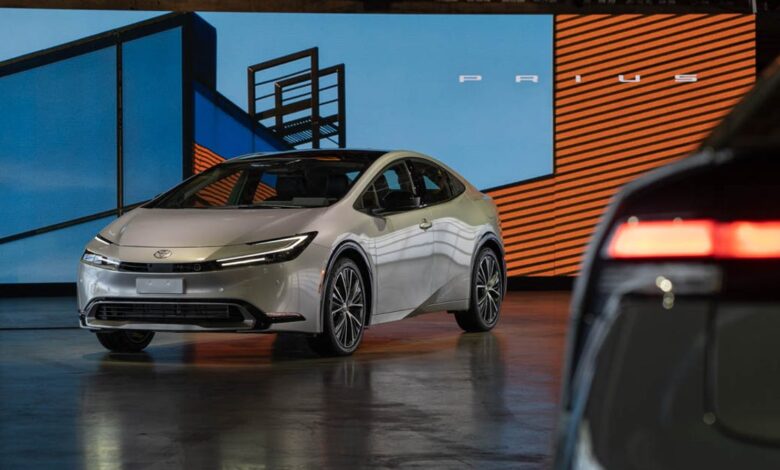Best Plug-In Hybrid EVs for 2024


2024 Chrysler Pacifica Plug-in Hybrid
Best PHEV for Large Families

2024 Volvo V60 T8 AWD Recharge
Our Favorite Sporty PHEV
I’ve had my finger on the pulse of all things automotive for the last 16 years: test-driving hundreds of cars, EVs, plug-in hybrids and following the news and trends in the auto industry. One trend that has become abundantly clear as of late is that full-electric vehicles are kind of a big deal.
EV adoption, infrastructure growth, public policy and climate-friendly transportation options are at the forefront of the news. Not every motorist is ready to take the full plug-in plunge. Perhaps you want to just dip a toe into the electrified lifestyle or maybe you’re waiting for charging and price to become more accessible in your area.
For these drivers, plug-in hybrids have re-emerged as a compelling green car alternative, blending some of the advantages of battery electric vehicles with the familiarity of combustion cars. Gathered here, you’ll find a selection of our favorite PHEVs you can buy in 2024.
What is the best plug-in hybrid?
For the best efficiency bang for the buck, look no further than the OG poster child for hybridization, Toyota’s Prius Prime. The Prime boasts up to 45 miles of EV range thanks to its extremely efficient design which, at around 3.8 miles per kWh in EV mode, rivals that of many dedicated electric cars. With regular recharges and top-ups at a normal 120-volt home outlet, many drivers may find themselves going days or weeks driving solely on cheaper electric power. That efficiency advantage continues even after the big battery is depleted, boasting an impressive 52 combined mpg for the next 500-plus combustion-powered miles, so you’ll spend less time and money at the pump on longer journeys.
For the Prius Prime, efficiency has always been paramount, but this new generation adds a pinch of style and a generous dash of pep to its winning formula.
What’s the difference between a plug-in hybrid and a conventional hybrid?
The biggest difference between a conventional hybrid and a plug-in hybrid is how the battery is charged. The HEV concept adds an electric motor/generator and a rechargeable battery to a combustion engine to improve fuel efficiency. Plug-in hybrids evolve this concept with the addition of a charging port.
The addition of a plug and a larger battery allows PHEVs to drive moderate distances on pure electric power before switching over to hybrid operation.
This upgrade allows the PHEV to be charged from an external power source, such as the utility grid, when parked and plugged in. Most PHEVs worth considering also feature a larger battery and a more powerful electric motor than their HEV ancestors, which allows them to operate on exclusively electric power for an increased distance before the combustion engine kicks in.
The electric range is significantly shorter than a dedicated EV, but even a few electric miles per day can make a difference with improved fuel efficiency, reduced tailpipe emissions and lower operating costs versus combustion and HEV cars. Trips and commutes shorter than their average 20-30 mile range can usually be completed without burning a drop of fuel. When the EV range has been exhausted, PHEVs can automatically switch to gasoline power, so you can keep driving for hundreds of miles without range anxiety.
The best plug-in hybrids for 2024

With the best EV range and efficiency of any PHEV for sale in the US today, the Prius Prime SE is balanced by some of the best performance ever offered in the Prius’ 27-year, five-generation lineage with satisfyingly torquey acceleration from its four-cylinder and reasonably nimble handling.
I’d also go as far as saying the new Prius Prime is one of the best-looking cars Toyota has designed in years with a sharp style that finally brings all of the weird design bits and aerodynamic elements that the automaker has been experimenting with for the last few generations into a handsome, futuristic package.
Additional attributes
- EV mode: 45 miles @ 127 mpge, 3.8 mi/ kWh
- Hybrid mode: 52 combined mpg
- Combined range: 600 miles
- Starting Price: $34,070

Toyota’s RAV4 Prime offers most of the Prius Prime’s efficiency in a package with a bit more space for people and cargo, especially tall backseat passengers, and a bit more ground clearance over uneven terrain.
The taller profile costs the RAV4 a few miles of range and fuel economy — dropping to 42 miles per charge and around 38 combined mpg thereafter — but makes up for it with an additional electric motor on the rear axle, imbuing the SUV with on-demand all-wheel drive and a surprisingly quick 5.5-second 0-60 sprint.
Additional attributes
- EV Range: 42 miles @ 94 mpge, 2.8 mi/kWh
- Hybrid efficiency: 38 combined mpg
- Total range: 600 miles
- Starting Price: $45,040

Kia’s flexible Niro is a rare bird, one of only a few vehicles offered in hybrid, plug-in hybrid and battery-electric configurations, giving drivers the full gamut of electrification choices at the point of purchase. And all three configurations are pretty good; none feels like a compromise.
The Niro PHEV is the Goldilocks of the group, with up to 34 miles of electric range and 48 mpg for the hybrid-powered miles thereafter. It’s not as efficient as the Prius Prime and a touch more expensive, but the Kia is also an SUV with more space for people and cargo. Think of it as getting RAV4 space for Prius money (with better dashboard tech than either) and it starts to make budgetary sense.
Additional attributes
- EV Range: 34 miles @ 108 mpge, 3.2 mi/kWh
- Hybrid efficiency: 48 combined mpg
- Total range: 510 miles
- Starting Price: $35,765

Chrysler’s plug-in people-mover, the Pacifica Plug-in Hybrid, is one of my favorite vehicles on the road… period. It’s just so good at the specific task it’s designed to do: transporting a bunch of people or cargo as efficiently as possible. Its 32 miles of EV range per charge is likely good enough to handle most of your daily around-town errands and grocery-getting without burning a drop of gas and, at up to 30 mpg combined in hybrid mode, it’s a reasonably thrifty family-hauling road tripper.
Plus, the Pacifica is one of a very few PHEVs that qualify for the full $7,500 federal EV tax credit, making it an even sweeter deal.
Additional attributes
- EV Range: 32 miles @ 82 mpge, 2.4 mi/kWh
- Hybrid efficiency: 30 combined mpg
- Total range: 520 miles
- Starting Price: $52,690

The Jeep Wrangler 4xe is an okay plug-in hybrid, but an awesome Jeep. Compared to a Prius or a Volt, its 22 miles of EV range (if you’re as efficient a driver as I am) isn’t super impressive by today’s standards and neither is its fuel economy once the battery taps out. Compared to the conventional Wrangler’s 17 combined mpg, however, the 4xe’s 20 to 49 combined mpge is perhaps one of the most dramatic efficiency glow-ups you could ask for. It’s also currently eligible for half ($3,750) of the Federal EV tax credit.
Plus, it’s still a fully Trail Rated Jeep, so I was able to tackle trails and bounce off of rocks while crawling and ford rivers in this PHEV as well as a regular Wrangler could, all while enjoying the great outdoors in relative silence. It’s also technically the only convertible on this list and, best of all, you can take the doors off with hand tools. Try doing that in your Prius.
Additional attributes
- EV Range: 22 miles @ 49 mpge / 1.5 mi/kWh
- Hybrid efficiency: 20 combined mpg
- Total range: 370 miles
- Starting Price: $52,590

The Volvo V60 Recharge is a handsome, athletic wagon that flies under the radar with its Scandinavian style and muscular proportions. Volvo’s legendary reputation for safety and driver assistance tech is balanced here with properly sporty performance. All-wheel drive is standard, the Polestar Engineered chassis feels quite nimble and it’s a quick one off the line. With 455 combined horsepower from its hybrid system, the V60 sprints from 0-60 mph in just 4.3 seconds.
Go easy on the accelerator and the V60 rewards with a solid 41 miles of EV range per charge and up to 31 mpg thereafter making it a solid and more luxurious PHEV option. For those who prefer the silhouette of a sedan, Volvo also offers the equally capable S60 T8 Recharge.
Additional attributes
- EV Range: 40 miles @ 74 mpge, 2.3 mi/kWh
- Hybrid efficiency: 31 combined mpg
- Total range: 530 miles
- Starting Price: $72,645

I know. I’m just as surprised to see a Mitsubishi on this list as you are, but the Outlander PHEV is an interesting and surprisingly compelling option for budget-conscious drivers who need a lot of space for not a lot of money. This capacious three-row SUV starts at around $40k, not much of a hybrid premium at all.
Also, it’s pretty good. The Outlander boasts up to 38 miles of electric range, which is impressive for a vehicle of this size. Once the big battery is drained, fuel efficiency drops to around 26 mpg, but the Outlander supports DC fast charging — a rarity for PHEVs — and can juice up to 80% (~30 miles) in 28 minutes. I also found the hybrid performance and acceleration satisfying during my time behind the wheel.
Additional attributes
- EV Range: 38 miles @ 64 mpge, 1.9 mi/kWh
- Hybrid efficiency: 26 combined mpg
- Total range: 420 miles
- Starting Price: $51,840
The best PHEVs for 2024 compared
| Name | EV Range | Hybrid Economy | Price | |
| PHEV Efficiency King | 2024 Toyota Prius Prime SE | 45 mi. | 52 mpg | $34,070 |
| Best AWD PHEV | 2024 Toyota RAV4 Prime 4WD | 42 mi. | 38 mpg | $45,040 |
| Affordable PHEV Alternative | 2024 Kia Niro PHEV | 34 mi. | 48 mpg | $34,765 |
| Best PHEV for Large Families | 2024 Chrysler Pacifica PHEV | 32 mi. | 30 mpg | $52,690 |
| Most Off-Road Capable PHEV | 2024 Jeep Wrangler 4xe | 22 mi. | 20 mpg | $52,590 |
| Our Favorite Sporty PHEV | 2024 Volvo V60 T8 AWD Recharge | 40 mi. | 31 mpg | $72,645 |
| PHEV Dark Horse | 2024 Mitsubishi Outlander PHEV | 38 mi. | 26 mpg | $51,840 |
(Note: All prices include destination charges.)
Other noteworthy PHEVs
Mainstream PHEVs
Kia’s Sorento and Sportage, as well as the Hyundai Tucson and Santa Fe are excellent and compelling mainstream SUVs that have recently added very desirable PHEV trim levels. More powerful and stylish than the Niro PHEV (although not quite as efficient,) all feature the same 1.6-liter turbocharged plug-in hybrid system averaging around 33-35 mpg combined, depending on the specific model and trim, and 30-34 miles of electric range per charge.
Luxury PHEVs
At the ultra-elite end of the spectrum, the Bentley Bentayga and Flying Spur PHEVs offset (but never compromise) their payloads of luxuries and creature comforts with an 18-21 miles EV range per charge and around 20 mpg thereafter.
The New Range Rover PHEV is one of the rare plug-in hybrids that can make use of a DC fast charging station.
Big battery range, but expensive
Meanwhile, the Land Rover New Range Rover (yes, that’s what it’s called) P440 PHEV rolls out with an impressive 51 miles of EV range per charge thanks to its absolutely massive (for a hybrid) battery. The P440 is also one of the rare PHEVs that features DC fast charging, adding around 40 miles in 30 minutes via its CCS connector. It’s as extremely off-road capable as you’d expect a Range Rover to be and as luxurious/expensive.
Most powerful (and least efficient) PHEV I’ve tested
The BMW, on the other hand, is all about speed with its 644-horsepower XM SUV. Its 31 miles of EV range is impressive, but the mere 14 combined hybrid mpg thereafter makes efficiency feel like an afterthought. Combine that with a face even a mother would be challenged to love and I was as confused by this PHEV’s seeming disregard for efficiency as I was thrilled by its neck-snapping acceleration.
What to consider when choosing a plug-in hybrid
Electric range
One of the key advantages of a plug-in hybrid versus a conventional, self-contained hybrid is the electric range you get when plugging in. More electric range means more miles driven without gasoline, which cuts down on tailpipe emissions and saves you money — since electricity is usually cheaper than gas. How much EV range a PHEV offers varies — from as low as 10 miles to as many as 50 — but on average you can expect around 20-30 miles per charge before the gasoline engine turns over.
Read more: Best Home EV Chargers for 2024
Studies have shown that, on average, PHEV owners don’t plug in as often as they could. Without the advantage of electric miles, a plug-in hybrid is just a heavier, slightly less efficient hybrid, so remember to plug in whenever you can to maximize the value and efficiency of a PHEV.
To reap the benefits of a PHEV, you must plug-in regularly. Otherwise, you’re just paying more for a heavier hybrid.
Hybrid efficiency
Of course, the advantage PHEVs offer over full-electric cars is their ability to operate on gasoline with quick fill-ups at familiar gas stations during longer journeys. Hybrid operation can vary wildly where efficiency is concerned, from as much as 50 mpg to as low as 14 mpg. More miles per gallon is always better, but this may not be the most important number on the spec sheet.
A driver who rarely road trips and chooses a PHEV with enough EV range to cover most of their daily driving may worry less about mpgs when they rarely use the gasoline engine. On the other hand, a driver who cruises beyond the EV range more often would want to maximize hybrid efficiency. And a driver whose habits include mostly long-range motoring may be better served with a conventional hybrid.
Price
PHEVs almost always feature larger batteries than their conventional hybrid analogs, which means they’re also usually more expensive. With regular recharges, a PHEV has the potential to save money in the long run by using electricity rather than gas for most trips. How long it takes to justify the “hybrid premium” will depend on the specific car and your driving habits, but you can estimate the break-even point with simple math.
A handful of PHEVs also qualify for the Federal EV tax credit, which could save between $3750 and $7500 and can now be applied at the point of purchase.
Making the leap to full EV
PHEVs have often been described as a gateway drug to full electrification, but fully electric cars are getting more affordable, more efficient and accessible every day. EVs are also simpler than PHEVs, with only one fuel source to keep track of and even less maintenance to worry about. As you examine your driving needs, habits and home charging capability, you may find that you’re more ready to make the leap to a full-battery electric car than you think. Keep an open mind as you shop.
How we test plug-in hybrids
Over the last 16 years, I’ve driven hundreds of conventional and electrified cars — from eco hatchbacks to luxurious SUVs — but the process always starts by getting behind the wheel and driving them in real-world conditions on public roads. For each car I test, I cover over 200 miles behind the wheel on a mixed driving route that includes dense urban roads (complete with potholes), long stretches of highway driving and some good fun twisty mountain roads mixed in for flavor.

I’ve driven almost too many hybrids and PHEVs to count.
For PHEVs, specifically, I test the electric range and the charging experience. I also compare the performance between full-electric EVs and hybrid operating modes, noting any inconsistencies or advantages revealed. As with all cars, I also evaluate driving dynamics including handling, acceleration and braking performance and also compare my real-world experience, tested range and efficiency with estimates reported by the US EPA, both to double-check the official numbers against the real world and to make sure my experiences represent those of the typical American driver.
Along the way, I also check each car’s cabin comfort, dashboard tech and driver aid and safety features to get a feel for where each vehicle fits in my experience testing hundreds of combustion, hybrid, hydrogen and, yes, battery-powered cars for CNET reviews.
PHEV FAQs
How long does it take to charge a PHEV?
Charging times depend on the PHEV’s battery and the power source, but most PHEVs can charge overnight (around 6-12 hours) when plugged into a standard household outlet. At a Level 2 home or public station, expect between 2-4 hours to fill up.
What happens if I don’t charge the battery?
When a PHEV’s battery is depleted, the vehicle reverts to regular hybrid operation, using the engine and regenerative braking to maintain a minimum state of battery charge. A PHEV can be driven like this for as long as there’s gas in the tank, although this will reduce the overall efficiency and negate some of the benefits of owning a PHEV.
Are PHEVs worth the extra cost compared to traditional vehicles?
The higher upfront cost of a PHEV can often be offset by fuel savings, government incentives and lower tailpipe emissions. The overall value depends on your unique driving habits, fuel prices and how often you plug in.
Are there incentives for purchasing a PHEV?
A handful of PHEVs currently qualify for the full or partial Federal EV tax credit. Local or state incentives, credits or rebates may also apply, so check your local policies. Some states also allow PHEV access to carpool or express lanes, saving you time, which is almost as good as money.






